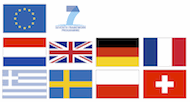Gilles Bellon (Météo France, Centre national de la recherche scientifique (CNRS)): Tropical and subtropical Cloud systems
After a PhD in 2004 on minimal models of the tropical climate at the University Pierre and Marie Curie in Paris, I went on to post-docs at the Indian Institute of Science, Bangalore, and Columbia University, New York, working on the idealized modeling of the intraseasonal oscillation of the Asian monsoon. I joined the Centre National de la Recherche Scientifique in 2008 and I have been working at the Centre National de Recherches M�t�orologiques since then. My current scientific interests encompass diverse aspects of the interaction between moist convection and dynamics, from its simple representation in single-column models to the simulation of tropical precipitation patterns in complete climate models, as well as tropical boundary layer dynamics.
Sandrine Bony (Dynamic Meteorology Laboratory (LMD)): Clouds and Climate Change
Hélène Chepfer (Dynamic Meteorology Laboratory (LMD)): Clouds and radiation
Françoise Guichard (CNRM-GAME, UMR 3589, Centre national de la recherche scientifique (CNRS) and Météo-France): Cloud Resolving Models
I am a researcher with CNRS working at CNRM-GAME in Toulouse, France. My work focuses mainly on atmospheric convective phenomena, either clear or cloudy and their phenomenology and connections with the surface energy budget. I am specially interested in the couplings and feedbacks between surface, boundary layer and convective processes arising within the diurnal cycle. Since the early 90's, I have made extensive use of models, especially large Eddy Simulations (LES) and Cloud Resolving Models (CRM) to study atmospheric convective phenomena. At first over tropical oceans, and now primarily over land, in West Africa. I am more familiar with models, but also enjoy analyses of observations, and participated to field campaigns in Mali where clouds are numerous, varied and spectacular during the monsoon. I am currently working at better understanding the shaping of the Sahelian climate by physical processes and their climatic sensitivity.
Cathy Hohenegger (Max Planck Institue for Meteorology, Hamburg): Clouds and Land Surface Interaction
My research interests are geared towards moist convective processes. Atmospheric convection profoundly affects the global energy and water balance of our planet by the release of latent heat and the transport of momentum, heat and moisture. Convective clouds and their associated precipitation can be found both over the Tropics and over mid-latitude area, over land and over ocean, during day and during nighttime. Due to their different characteristics and the involved complex scale interactions, they are difficult to predict.
Currently, I am working on following aspects of the convective life cycle:
Preconditioning of tropical deep convection
Convective parameterization development
Interactions between soil moisture and convection over mid-latitude continental area.
Christian Jakob (Monash University): Evaluation of clouds in large-scale models
I am a professor in Atmospheric Science at the School of Mathematical Sciences of Monash University in Melbourne, Australia. I am currently also the Deputy Director of the Australian Research Council's Centre of Excellence for Climate System Science . My research focusses on computer models of Earth' atmosphere as they are used to make weather forecast, predictions of the next season as well as simulations of our current and future climate. In particular I am working on the representation of clouds and thunderstorms in such models. These play a major role in the way energy and water are cycled through the atmosphere and hence are crucial ingredients of the climate system.
Louise Nuijens (Max Planck Institute for Meteorology, Hamburg): Introduction and Overview
I am interested in the interaction of shallow convection with its large-scale environment, and in particular shallow cumulus clouds, such as found in the trades. While working on this topic, I have used ground-based and space-borne remote sensing data, Large-Eddy Simulation and simple (bulk) models, and it is especially the combination of these different tools that I enjoy. Using observations from the Rain In Cumulus over the Ocean field campaign and Large-Eddy Simulation I have worked on characterizing the frequent occurrence of warm rain showers from these clouds in the trades, on understanding how the thermodynamic structure of the atmosphere impacts warm rain formation (versus the ambient aerosol), and how the structure of convection is influenced by wind speed, surface fluxes and large-scale subsidence. Currently I am leading a group of scientists and students that work on the analysis of observations collected at the Barbados Cloud Observatory - a measurement site on Barbados that continuously measures the properties of clouds, rain, aerosol and meteorology using radar and lidar systems. It is the first long-term observational record within the trades of this kind, and using the data collected there, our group strives to answer long-standing questions about trade-wind cumulus, that are thought to play a major role in the uncertainty in the low-level cloud feedback and climate sensitivity predicted by climate models.
Hanna Pawlowska (Institute of Geophysics, Faculty of Physics, University of Warsaw): Cloud microphysics Hanna Pawlowska (University of Warsaw): Cloud microphysics Hanna Pawlowska is professor in the Institute of Geophysics, Faculty of Physics at the University of Warsaw. She is an expert on experimental study of cloud microphysical properties. Her research interests include aerosol-cloud interactions. Recently she started towork with her PhD students on problems releted with representation of microphysics and processes influencing cloud microphysis in LES models. Presently she participates in EUCLIPSE project.
Johannes Quaas (University Leipzig)
After studies of Physics and Meteorology in Essen and Cologne, Germany, Johannes Quaas received his PhD from the �cole Polytechnique for with a thesis on aerosol indirect effects performed at the Laboratoire de M�t�rologie Dynamique in Paris, France. He worked as a post-doc at the Max Planck Institute for Meteorology (MPI-M) in Hamburg, Germany, and at the Met Office in Exeter, UK, before receiving a grant for a Junior Research Group at MPI-M. Johannes Quaas is Professor for Theoretical Meteorology at the University of Leipzig since 2011. His research focuses on improving the understanding and quantification of anthropogenic climate change. On the one hand, this involves the assessment of cloud-climate feedbacks, and the evaluation and improvement of cloud parameterisations in general circulation models. On the other hand, his research aims at a better quantification of aerosol-cloud interactions and the implied radiative forcing by anthropogenic aerosols. One of his main research interests in this regard has been the exploitation of satellite data for improving estimates of the aerosol indirect radiative forcing.
Stephan de Roode (TU Delft): Conceptual and Theoretical Model
Dr. Stephan de Roode is Assistant Professor at TU Delft. He obtained his PhD (1999) at the Institute for Marine and Atmospheric Research Utrecht (IMAU), Utrecht University, on the basis of a study on the aircraft observations of cloud-topped boundary layers and mass-flux parameterizations. He has worked at the Royal Dutch Meteorological Office (KNMI), the University of Washington (Seattle, WA, USA), and the Naval Postgraduate School in Monterey (CA, USA) where he studied aircraft observations and large-eddy simulation results of boundary layer clouds to improve parameterizations schemes used in weather forecast and climate models. He took part in the Surface Heat and Energy Balance of the Arctic Ocean (SHEBA) experiment and the Baltex BRIDGE measurement Campaign (BBC). He is currently leading the EUCLIPSE working package "Process level evaluation" which, as one of the main tasks, uses field observations to evaluate results from climate models.
A. Pier Siebesma (KNMI, TU Delft): Representation of clouds in large-scale models
Prof. dr. Pier Siebesma is senior scientist in the Regional Climate Division of KNMI and part-time professor at the University of Delft. He is an expert on planetary boundary layer physics and has developed improved convective parameterizations for the ECMWF weather prediction model. Since 2007 he is chair of the GEWEX Cloud Systems Studies (GCSS) and member of the GEWEX Modeling Prediction Panel (GMPP). His main interest is in the understanding, modeling and parameterization of cloud related processes, including cloud physics, cloud dynamics, cloud structures, and moist convection. As such he has been involved in Past Field Campaigns (RICO, BBC), in Large Eddy Simulation (LES) to develop parameterizations for operational ESMs and in the evaluation of the performance of such large scale models. He is currently the coordinator of the ongoing EUCLIPSE FP7 project on cloud-climate feedbacks.
Bjorn Stevens (Max Planck Institute for Meteorology, Hamburg): Cloud Dynamics
Dr. Bjorn Stevens is a director at the Max-Planck-Institute for Meteorology where he leads the Atmosphere in the Earth System Department and is a professor (�17) at the University of Hamburg. Prior to moving to Hamburg Dr. Stevens was a full professor of Dynamic Meteorology at the University of California of Los Angeles. His research blends modeling, theory and field work to help articulate the role of clouds and atmospheric convection on the climate system. Dr. Stevens has made pioneering contributions to our understanding of mixing and microphysical processes on the structure and organization of marine boundary layer clouds, whose statistics regulate the flow of energy through the Earth system. Small changes in such clouds can greatly amplify, or dampen, perturbations to the Earth system Dr. Stevens received a PhD in Atmospheric Science in 1996 from the Colorado State University in Ft Collins CO, and holds a Bachelor and Masters of Science in electrical engineering from Iowa State University. He has contributed more than 90 scholarly articles to the peer reviewed literature. Dr. Stevens serves on a number of international advisory boards, has served as editor of leading journals in his field and has been honored by a number of awards, including fellowships from the Advanced Study Program of the National Center for Atmospheric Research, and the Alexander von Humboldt Society. In 2002 he was chosen as the recipient of the prestigious Clarence Leroy Meisinger Award of the American Meteorological Society for "pioneering advances in understanding and modeling of cloud-topped boundary layer.
Gunilla Svenson (Stockholm University): Extratropical and Polar Cloud systems
I am working at Department of Meteorology, Stockholm University (MISU). My research is mainly theoretical model development. I use models in combination with observations to study various phenomena. The studies have lead to model developments, both writing of new submodels and adapting existing models. My doctoral thesis was environmental modeling of the air quality in Athens, Greece. My post-doctoral period in John Seinfeld�s group at CALTECH was devoted to modeling of boundary layer clouds, concerning both the cloud microphysic and the turbulence produced by clouds these clouds. Modeling the stably stratified boundary layer, especially the Arctic boundary layer, interests me. My current research projects concern global climate models and how these small-scale processes, turbulence and clouds and how they interact with radiation, are described in them. This work is done in collaboration with NCAR, USA and the EC-Earth consortium. I am the climate model coordinator in the Bolin Centre for Climate Research at Stockholm University. International engagements include co-chair of the GEWEX Atmospheric Boundary Layer Study (GABLS), member of the Steering Group of WWRP Polar Prediction Project and Science Steering Committee of Global Atmospheric System Studies (GASS).















